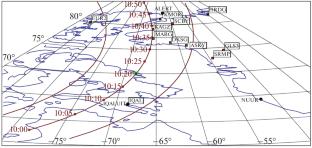Solar eclipses (SEs) cause a variety of processes in all geospheres. There is a decrease of electron density, as well as electron, ion, and neutral temperature, in the ionosphere; the dynamics of ionospheric plasma changes significantly, wave disturbances are generated, and the interaction between subsystems in the Earth–atmosphere–ionosphere–magnetosphere system increases. It has been proven that SE effects depend on the solar eclipse magnitude, geographical coordinates, time of day, season, atmospheric and space weather conditions, position in the solar cycle, and other factors. In addition to recurring or regular effects, there are effects specific to a given SE. For this reason, the study of physical processes in all geospheres caused by SEs is an urgent interdisciplinary problem. The purpose of this work is to present the results of the observation and analysis of time disturbances of the vertical total electron content (TEC) in the Arctic. The data used in this study include the parameters of signals received by a network of stations from navigation satellites passing over the Moon’s shadow, where the SE magnitude was approximately 0.9 in the latitude range 70…80° N. The annular solar eclipse of June 10, 2021, began at 08:12:20 UT and ended at 13:11:19 UT. The Moon’s shadow appeared first over Canada then moved across Greenland, the Arctic Ocean, the North Pole, and the New Siberian Island. The Moon’s shadow covered the northern part of the Russian Federation. Partial SE was observed in northern and middle parts of Europe, most of the Russian Federation, Mongolia, and China. Using 11 ground stations that received GPS signals from 8 satellites, the authors studied the spatial and temporal variations of the TEC during the maximum coverage of the solar disk, which was observed in the Arctic, and found the following. The decrease in electron density for each station and each satellite was observed almost immediately after the beginning of SE and lasted approximately 60…100 min. The minimum TEC value was then detected, followed by an increase to the initial value or higher. The average TEC was 6.4…10.4 TECU. The average decrease in TEC was 2.3 ± 0.6 TECU from 8.4 ± 1.6 TECU. In relative units, the decrease ranged –16.5…–46% (average value –30 ± 9.7%). The time delay between the start of the minimum TEC value relative to the maximum SE magnitude was determined. It varied within 5…30 min (mean value was 18.3 ± 8.5 min). In some cases, quasi-periodic variations in TEC with a period of 9…15 min and a relative amplitude of 3…5% were observed during the SE.



